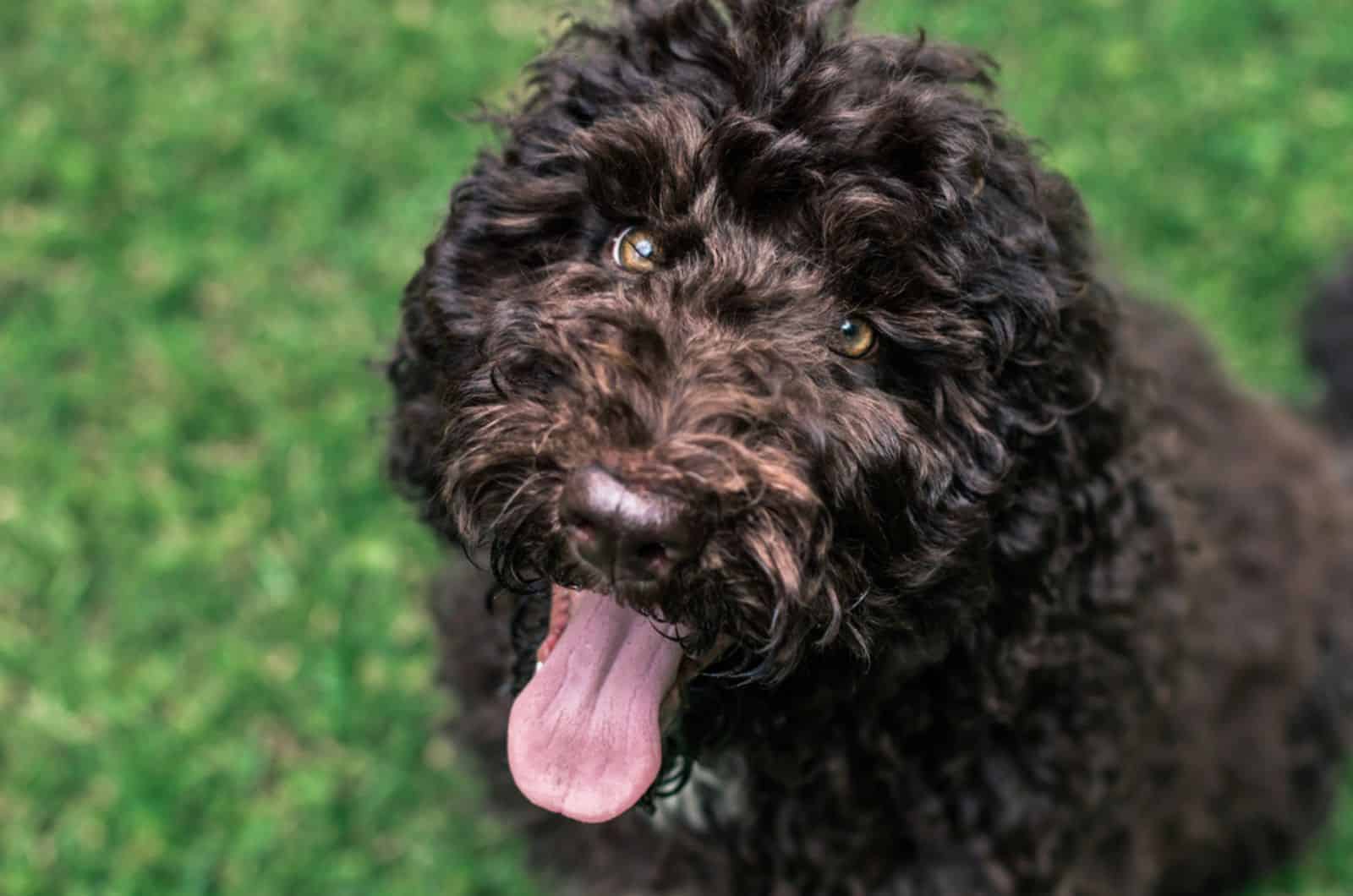The popular doodle known as the Shepadoodle is a cross between a German Shephard and a Poodle.
When you think of Poodle mixes, your first thought are probably Goldendoodles, Labradoodles, or even Bernedoodles. However, The German Shepherd Poodle mix has been catching a lot of attention lately.
Although the dispositions of a Poodle and a German Shepherd are very different from one another, they combine to create an excellent doodle dog. These animals are quite big, very fluffy, trainable, hypoallergenic, and non-shedding.
Shepadoodles are good with kids and make wonderful family pets, so they are a great choice if you have a big family.
Are you considering bringing home a Shepadoodle puppy? In this post, we will study the German Shepherd Poodle mix and its expenses, nutritional requirements, disposition, and more!
What Exactly Is The German Shepherd Poodle Mix?
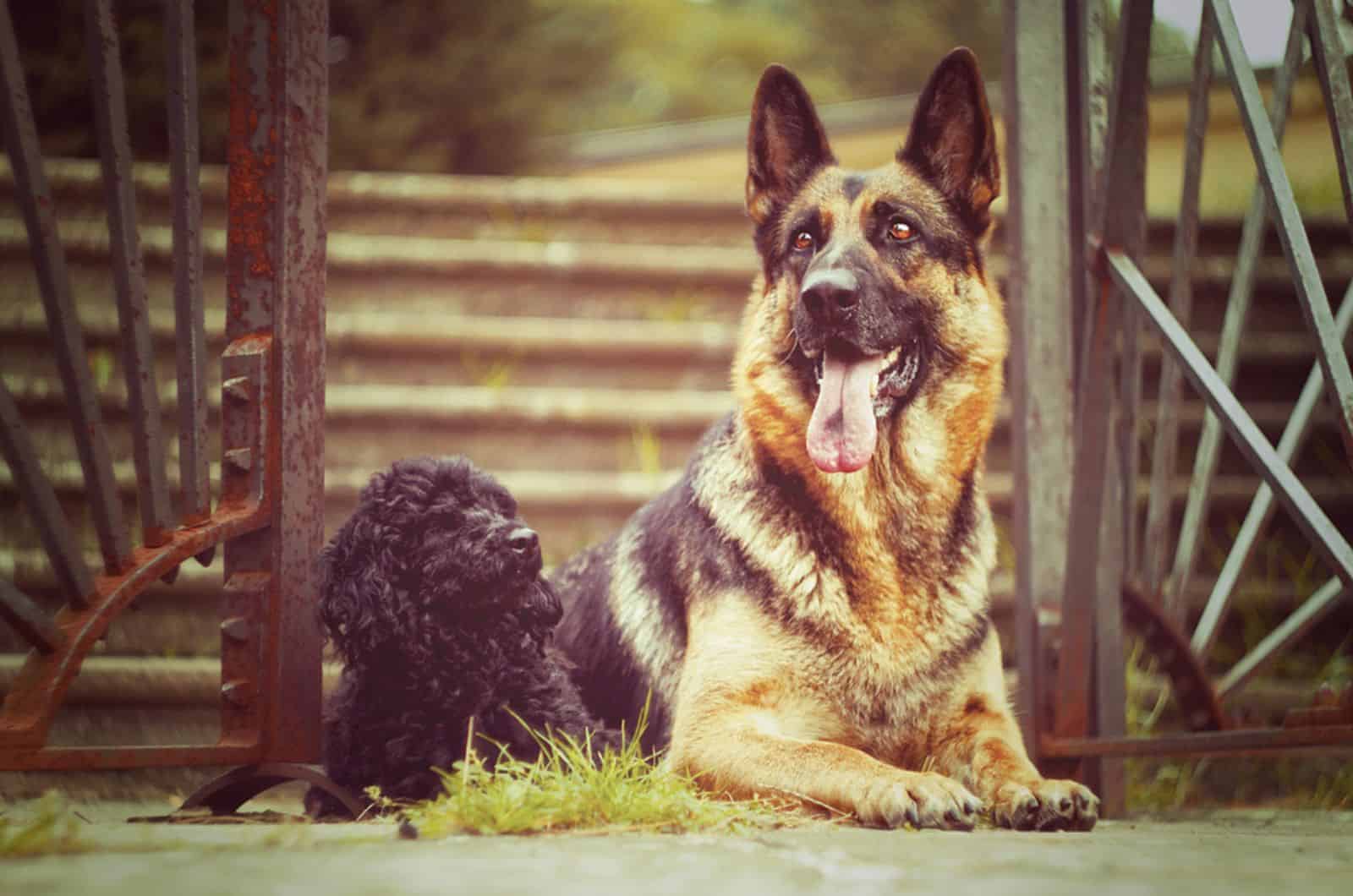
We talk about mixed breeds often on this website, and a lot of them are truly special, for one reason or another. However, this particular combination is a true superstar, even though it has not been around for long.
The German Shepherd Poodle mix is, obviously, a dog breed created by crossing two well-known and belove purebred dogs — the Poodle and the German Shepherd.
It is known by many pet names, like Shepapoo or Shepdoodle, but probably the most common one is Shepadoodle, so we will mostly be using that one.
Despite being from the same country — i.e. Germany — the German Shepherd and the Poodle are remarkably distinct from one another. However, since they are both so popular, it’s no surprise that both have been the sources of many mixed breeds.
For example, here is a list of some of the cutest German Shepherd mixes, and a list of the most adorable Poodle mixes.
What Are Shepadoodles Like?
A beautiful and balanced family dog, the Shepadoodle truly possesses the best of both worlds because it is a friendly and obedient, gentle and entertaining dog breed.
It should only be placed with households that can handle a higher-energy dog due to its exercise requirements. You must be able to provide daily amounts of exercise and a lot of mental stimulation.
It also requires a large living place because it is quite a big dog. You’ll also need to be ready to deal with its occasionally overbearing demeanor. We will talk more about all the needs you will have to meet later on in the article.
Before that, let’s share some breed information about the parents, because that will help us set the foundation for this crossbreed and better understand its personality.
German Shepherd Breed
The German Shepherd is a purebred dog that was developed in Germany in the 1800s as a herding dog and as a predator deterrent.
Due to their obedience and loving personalities, they were only used as farm dogs and were not kept as domestic pets until just before World War I.
The German Shepherd dog gained enormous popularity and quickly rose to the top of the list of canine breeds used by the military, police, search and rescue teams, and people with disabilities. It is one of the best service dogs around, without question.
After the Golden Retriever, the German Shepherd is the dog breed with the second-highest number of AKC registrations.
The GSD is a big dog, weighing anything from 50 to 90 pounds, and measuring from 22 to 26 inches in height. It is usually described as self-assured, brave, and intelligent, and it typically views one member of its family as its primary master.
They will look to this person as their leader, and they frequently form strong bonds with him or her. The GSD is a very popular parent breed to mix because of how well-liked it is.
Poodle Breed
The Poodle is initially from Germany, where they were utilized for bird hunting and other water-retrieving activities, because of their water-resistant curly coats.
The Poodle is also one of the most intelligent dog breeds and makes wonderful pets, thus various varieties started to appear. Poodles come in a variety of hues, including black, white, apricot, blue, grey, and others.
Due to their reputation as hypoallergenic and non-shedding, these are also among the breeds with the highest number of AKC registrations. This implies that if you have pet allergies of any kind, this dog won’t aggravate them and make you sneeze all day.
The Poodle is the seventh most popular dog breed in America right now, according to the American Kennel Club, and is best characterized as intelligent, active, and proud.
Poodles come in three sizes. Every size is only an exact duplicate of the others, except bigger. The Miniature Poodle is under 15 inches tall, the Toy Poodle is 10 inches or shorter, and the Standard Poodle is 15 inches or taller.
Depending on the Poodle’s size, there can be either big or small Poodle mixes. The Shepadoodle will probably be on the bigger side!
The Shepadoodle‘s parent is normally a Standard size Poodle for simplicity in mating and giving birth, although miniature poodles are also common parent breeds for various hybrid dogs.
German Shepherd Poodle Mix Appearance
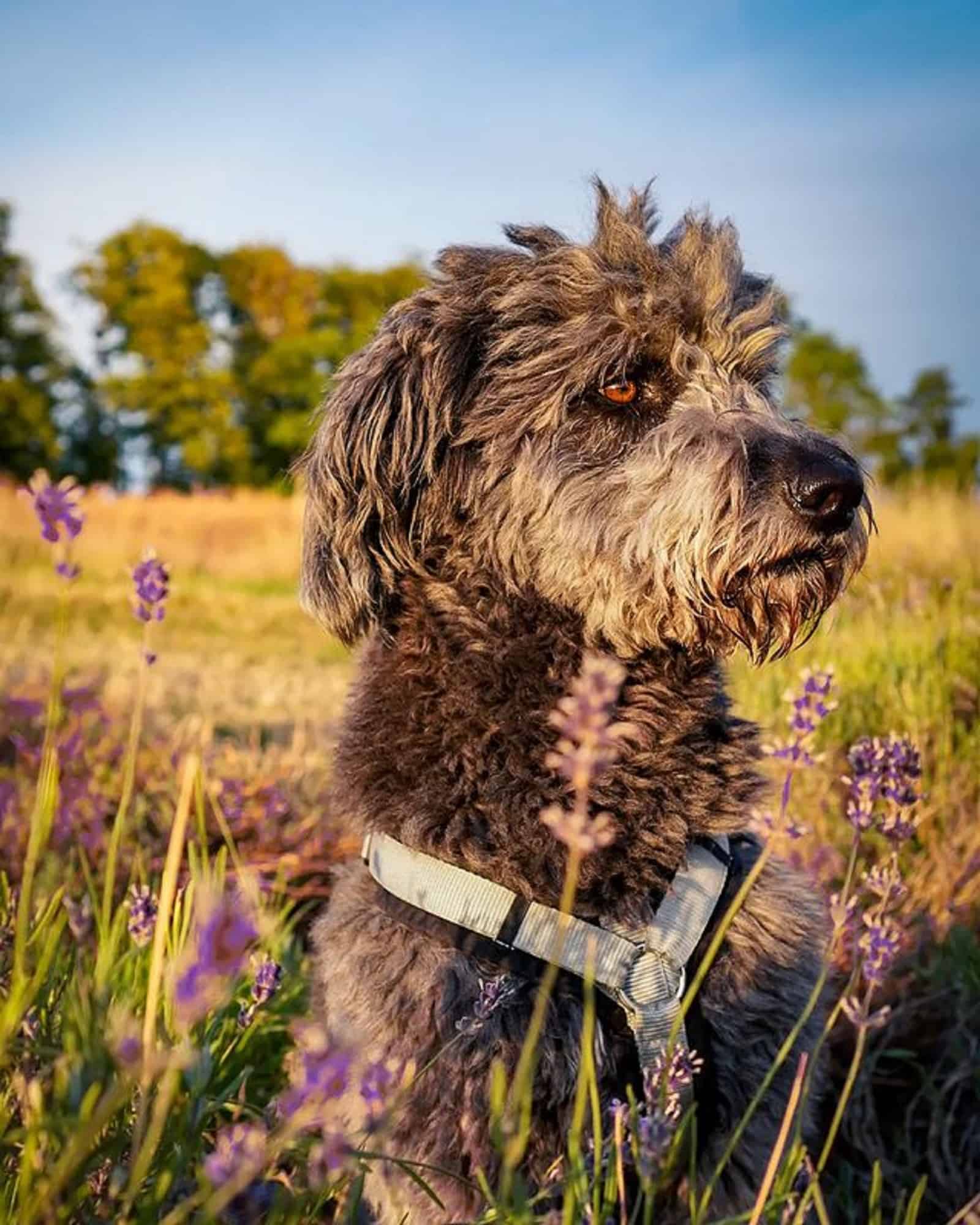
The appearance of the Shepadoodle breed can vary greatly, due to the differences in its parent breeds. For example, Poodles can have many colors, while German Shepherds are always pictured in their trademark black and tan combo, even though they have other variations.
However, there are some physical traits that are common to all German Shepherd Poodle mix dogs.
Under their coats, these dogs are incredibly muscular. While you might not immediately see their well-defined muscles, you will quickly become aware of their strength and power.
Furthermore, their ears will probably be a huge triangle form, and they will have large, black eyes.
Let’s now focus on the two main aspects of the German Shepherd Poodle mix’s appearance, which are its size and its coat color.
Shepadoodle Size
Typically, it is the size of the Poodle parent that determines how big the Shepadoodle will be, but the size of the German Shepherd will also play a role.
When German Shepherds are crossed with a Standard Poodle, the result is a Standard Shepadoodle.
From the tips of their paws to the top of their shoulders, Standard Shepadoodles will stand anywhere between 18 and 24 inches tall. In terms of weight, once they are fully grown, these dogs will weigh between 50 and 80 pounds.
There are also other size variations, but we will talk more about them later on in the article.
Shepadoodle Coat Types And Colors
Shepadoodles often have a black and brown fur coloration. Additionally, they can be a single dark hue or a combination of black, brown, sable, and white.
Based on the parent Poodle’s coat color, you can typically get a fair notion of what color the Poodle and German Shepherd mix will be. Due to the wide variation in Poodle colors, which range from white to apricot to black, you can typically determine the general color of your dog based on the Poodle color.
Dark hues like black and tan will typically be present, along with the father German Shepherd’s face marks.
German Shepherds typically have those trademark black and brown coats, and each dog generation sees less variation in their genes and color.
In terms of coat type and texture, it’s likely that their coat will be loosely curled or wavy, with a rough, wiry feel to it.
The German Shepherd can have hair that is either short or long, but when combined with the Poodle coat, the result is usually a medium-length coat.
Another thing that greatly impacts the type of coat a German Shepherd Poodle mix will have is its generation. Breeding generations can sometimes seem complex and difficult to grasp, but we will try our best to explain them in simple terms in the following section of the article.
German Shepherd Poodle Mix Generations
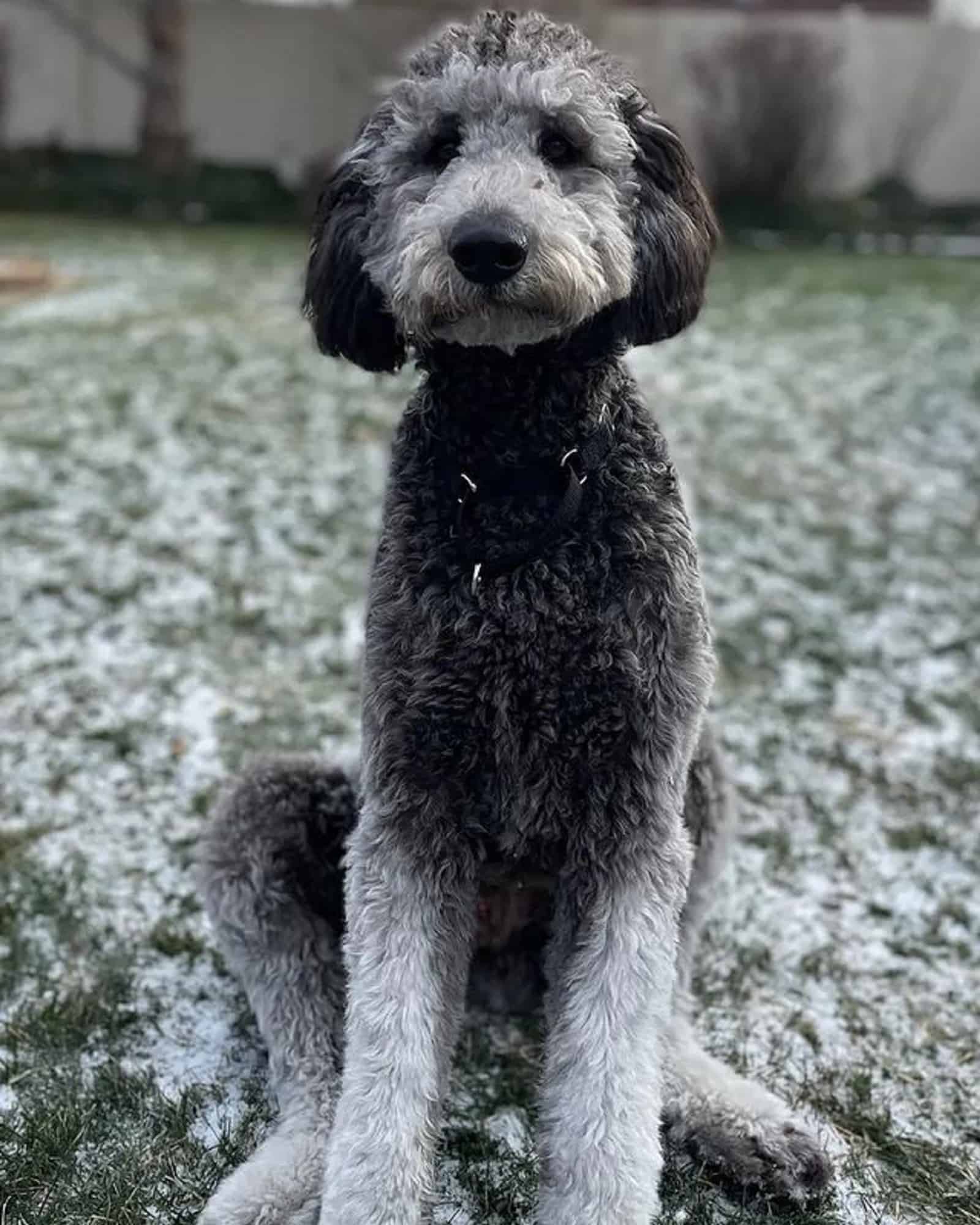
Depending on the parents’ ancestry and whether they have more German Shepherd or Poodle genetics, different Shepadoodle coat types exist.
Shepadoodles with more Poodle bloodlines tend to have curlier, hypoallergenic, and non-shedding coats. Shepadoodles will have straighter coats and shed more frequently if they are more like their German Shepherd parents.
The first thing to know is that the letter F stands for filial, which simply denotes that your dog is a hybrid.
Second, the number 1 designates a dog’s generation, indicating that it is the first generation of crossing, i.e. a purebred GSD was mixed with a purebred Poodle.
Last but not least, a letter B could be present, denoting the existence of backcrossing. Backcrossing is the process of mixing a Shepadoodle with one of its parent breeds, most commonly the Poodle because it increases some of its most desirable traits, such as non-shedding.
F1 Shepadoodle
When you cross a purebred German Shepherd with a purebred Poodle, the result is a dog that has a roughly 50/50 share of their genes, and that is what is labeled as an F1 mixed breed.
Since the F1 Shepadoodle is a relatively recent breed that is becoming popular, when people say they have one, they most likely mean an F1 Shepadoodle. Similar is true for other doodles, such as the F1 Goldendoodle, for example.
It is, however, nearly impossible to tell what kinds of features and coat types the Shepadoodles will have given that this is only their first generation.
F1B Shepadoodle
A Shepadoodle (50 percent Poodle, 50 percent German Shepherd) and a Poodle are crossed to create an F1B Shepadoodle.
An F1B Shepadoodle results in a dog that is 75% Poodle and 25% German Shepherd due to the backcrossing to a Poodle in this generation. This usually results in a coat that is more curly and wavy and resembles a Poodle.
Backcrossed Shepadoodles to Poodles are often preferred by pet owners because they are significantly more hypoallergenic and non-shedding than F1 Shepadoodles.
A great example of this is the F1B Labradoodle, which is often cited as one of the most desirable doodles of all.
German Shepherd Poodle Mix Size Variations

As we already said, there is more than one option when it comes to the size of a Shepadoodle. While Standard Shepadoodles are the most common ones, because of the ease of mating between German Shepherds and Standard Poodles, there are also smaller versions.
Let’s talk about the Mini Shepadoodle and the Toy Shepadoodle.
Mini Shepadoodle
A mix between a Miniature Poodle and a medium-sized German Shepherd, which weighs normally between 35 and 45 pounds, is known as a Miniature or Mini Shepadoodle.
Since these are supposed to be miniature dogs, the name sounds a little strange, but for the Shepadoodle breed, this is indeed a miniature dog.
Producing this variation of the Shepadoodle requires a Mini Poodle parent, so it makes sense to check out the best Miniature Poodle breeders available.
Toy Shepadoodle
Toy Shepadoodles, often called Micro or Petite Shepadoodles, are the tiniest Poodle and German Shepherd mixes available.
They normally weigh 25 to 35 pounds and are produced by breeding a toy male Poodle and a medium-sized female German Shepherd. These are excellent pets for those who don’t have a yard for their dog to run around in or who live in smaller homes, apartments, or condos.
If you’re hoping to get yourself one of these dogs, your best bet is probably exploring some breeders who specialize in producing Toy Poodles.
German Shepherd Poodle Mix Temperament
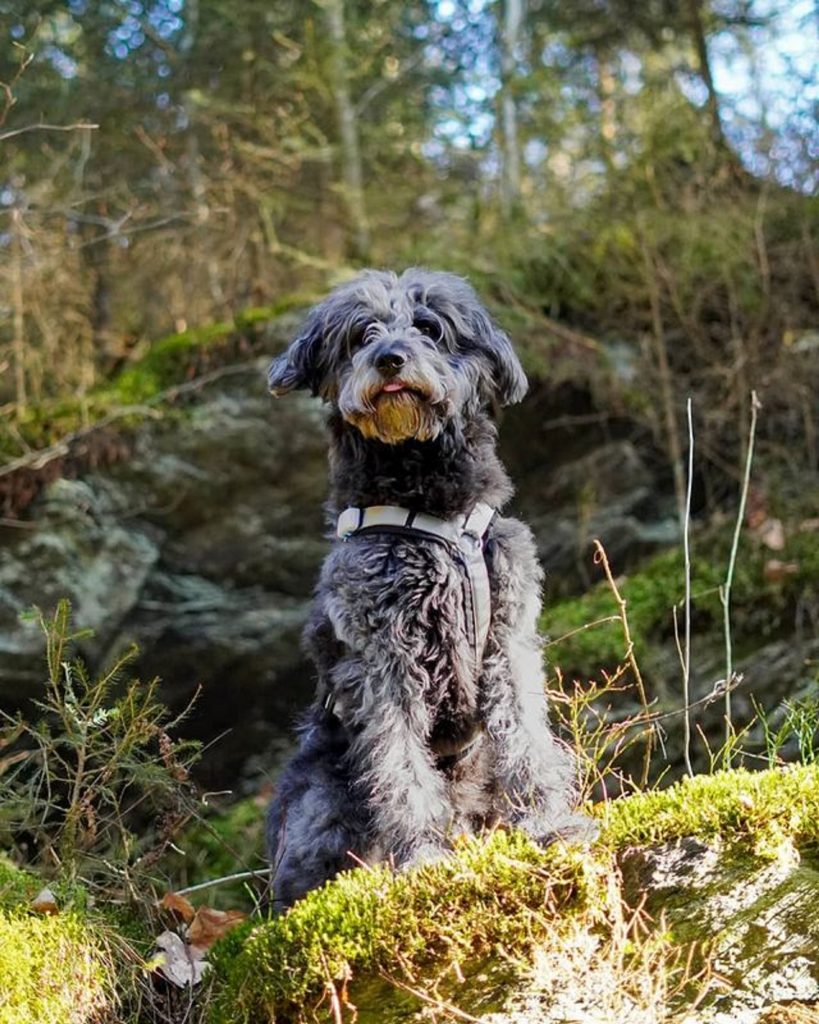
Despite their great differences in appearance, German Shepherds and Poodles have several features in common. Both breeds are regarded for their intellect, athleticism, trainability, and need for mental stimulation.
Additionally, they were both created as working dogs. Shepadoodles, a cross between a German Shepherd and a Poodle, exhibit all of these traits.
For seasoned dog owners, a well-exercised Shepadoodle makes a wonderful companion. In order to prevent its sharp mind from becoming bored, it needs an owner who can keep it busy and interested.
The guarding traits it received from its mixed-breed parents will probably cause this dog to first be a little reserved with strangers. They might even bark at first, but, once they get to know someone, they will warmly welcome them into the pack with a smile and lots of doggy kisses.
This is due to the Poodle parent’s exceptional sociability. It might err on the side of being aloof or sociable, but you can be sure that he will be a well-balanced pup in terms of friendliness.
And when it comes to its family, well, the love and affection for its immediate pack cannot be contained.
Are Shepadoodles Aggressive?
Shepadoodles are not frequently regarded as an aggressive breed. Despite being strong, devoted, and loyal, they are not aggressive. This kind of dog is renowned for both its vivacious personality and for being devoted and loyal to its owners.
However, some people equate violence with loyalty. Your Shepadoodle may want to assert itself and take charge if it feels that you or your home are in danger. To control this, you should learn how to establish your own dominance.
They may growl or bark, but they won’t act aggressively right away. During this time, you’ll frequently be able to maintain control over them and order them to stop if necessary.
How To Train Your Shepadoodle
These canines are clever and flourish in training since they are inherently devoted and inquisitive.
For potential owners, this is excellent news. While it might be appropriate for new dog owners, you should educate yourself on how to deal with dogs that might act in a protective manner. Socializing aggressive dogs is a sensitive concept.
Or, if in doubt, just sign your dog up for a puppy obedience class to get its manners off to a good start.
Socialization is a crucial component of its training since it produces polite, self-assured dogs. As we’ve already said, Shepadoodles aren’t naturally aggressive dogs, but socializing them early will remove any potential for them developing aggressive tendencies.
Verbal praise will motivate the German Shepherd parent, whereas toys or treats will typically motivate the Poodle parent, so be sure to include both of these in your training as well.
German Shepherd Poodle Mix Nutrition

The Shepadoodle will thrive on high-quality premium kibble designed for large breeds like German Shepherds or Standard Poodles. Additionally, it should be rich in protein to provide its powerful, energetic muscles with the strength and energy they need.
An average adult Shepadoodle dog needs about three cups of kibble per day.
Feeding your pup age-appropriate kibbles made especially for large dogs is crucial because they are in danger of developing hip and elbow dysplasia due to their size.
The amounts of calcium, phosphorus, fat, and vitamin D in these premium foods are well-balanced and they make your dog less likely to get these ailments.
German Shepherd Poodle Mix Physical Activity And Living Space Requirements
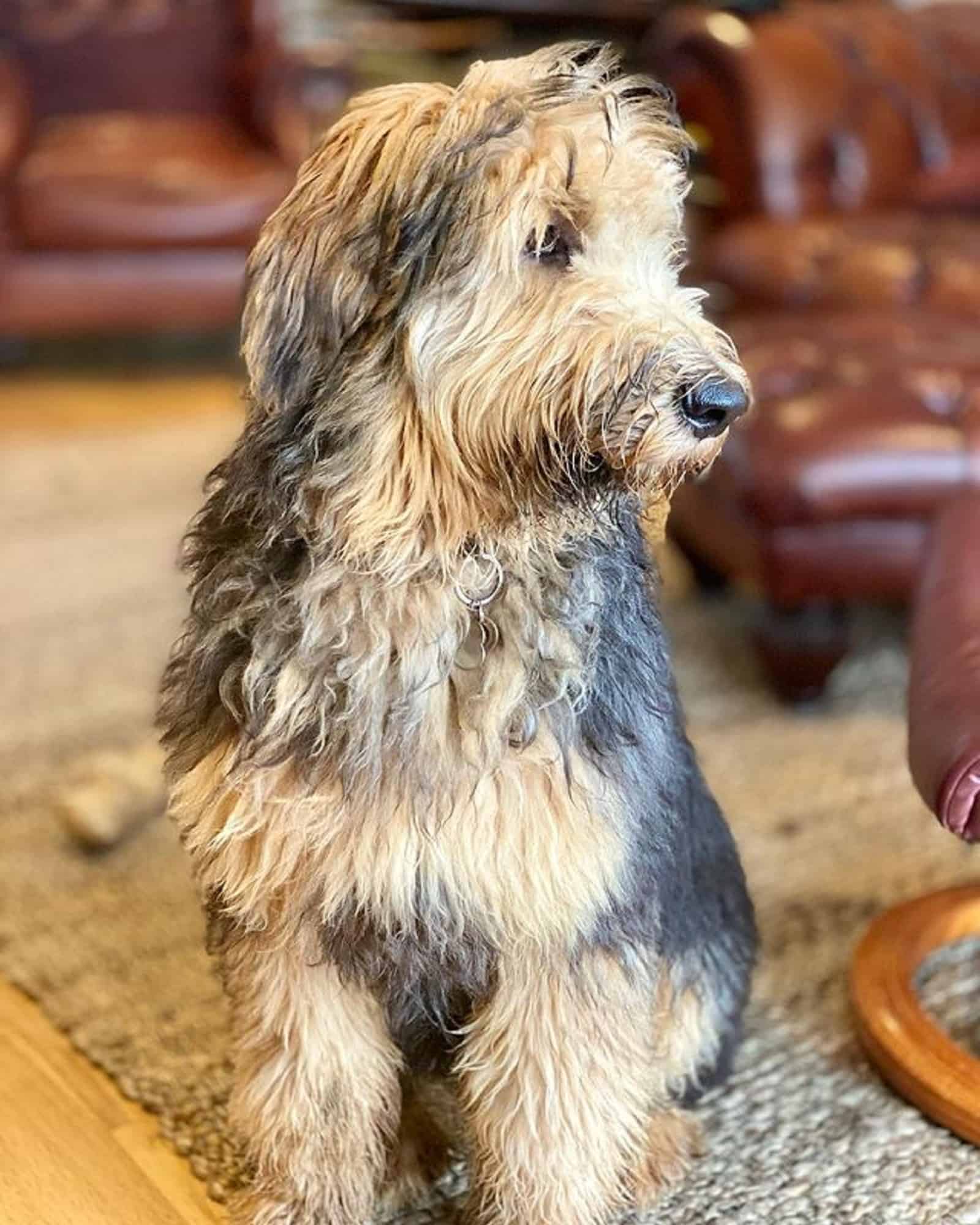
The Shepadoodle is typically descended from the Standard Poodle, so you can anticipate a big dog that will require a lot of living area. They require entry to a backyard as well.
Of course, there may be some breeders of Miniature Shepadoodles, so in that case, you should anticipate a smaller dog that won’t require as much space. Speaking with the breeder and viewing the parents are the only ways to find out its potential size.
You may be certain that it will require a large house with access to a sizable backyard if one of its parents is a Standard Poodle. Otherwise, you might anticipate your dog developing cabin fever and acting out.
These dogs make a great watchdog because of their devotion to their owners and their suspicion of others. They don’t exactly make our list of the best big guard dogs, but they are still more than capable of the job.
You may rely on them to inform you if there is any danger nearby, which is excellent if you enjoy this characteristic in dogs, but not so excellent if you live in an area where there are noise limits or sensitive neighbors. If a barking dog is a deal-breaker for you, keep this in mind.
Despite their size and enthusiasm, they get along well with kids and other animals. They are capable of residing in homes with multiple pets and young families.
Just keep in mind that their boisterous nature may make them unsuitable for families with young children since they could unintentionally knock them over. As always, never leave kids unattended, just like you wouldn’t with any other dog.
German Shepherd Poodle Mix Grooming
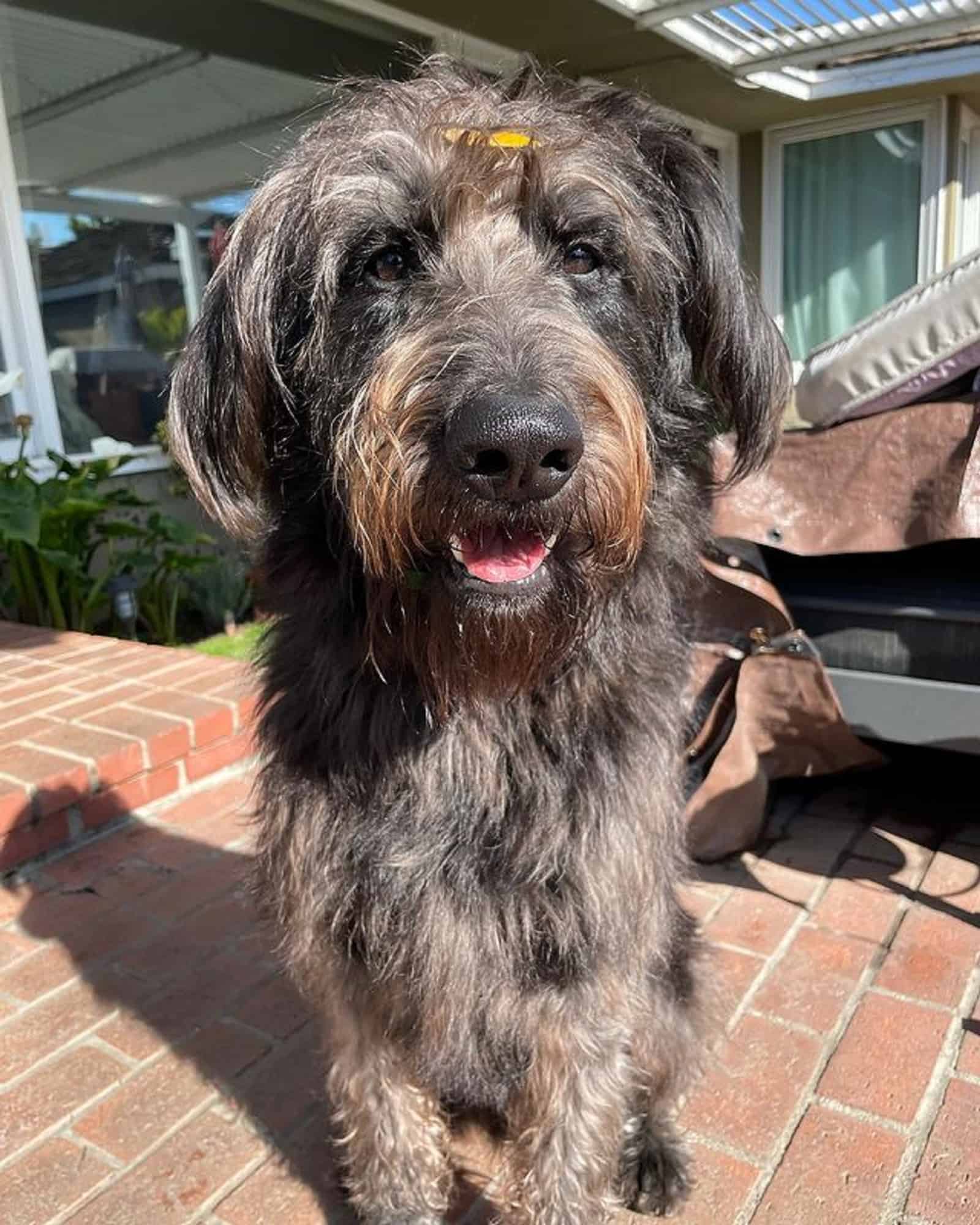
Given their curly or wiry coat, the Shepadoodle will require brushing every other day. This should be raised to daily brushing if your pup has a longer coat or if it is particularly prone to matting.
A slicker brush will be your finest piece of grooming equipment in this situation.
Furthermore, Shepadoodles will require bathing every six weeks or so, but you should avoid the temptation to bathe them more frequently than that, in order to avoid messing with their natural coat oils.
As part of providing care to your Shepadoodle, keep in mind that regular dental cleanings, flea, tick, and heartworm preventives must be given on a monthly basis. Additionally, examine and clean its ears, particularly if it spends a lot of time swimming.
If you are unable, or don’t have the time, to keep up with such a grooming routine, perhaps consider taking your Shepadoodle to a professional groomer every once in a while.
German Shepherd Poodle Mix Health

Shepadoodles have an average lifespan of 10 to 15 years and are generally healthy canines. This is partly due to hybrid vigor, but it should also be noted that both of their parent breeds are usually exceptionally healthy.
In fact, both German Shepherds and Poodles make our list of the healthiest dog breeds in the world.
However, that doesn’t mean that they are without health risks.
Common Health Problems In Shepadoodles
Being mixed-breed puppies, Shepadoodles are also susceptible to the health issues of both parents.
Both Poodles and German Shepherds are usually fairly healthy — especially Poodles — but they are known to occasionally develop certain medical conditions. Some of these can be congenital and passed down to their mixed offspring.
The main issues to watch out for are listed down below.
Progressive Retinal Atrophy
Progressive retinal atrophy, a set of eye conditions that result in the degeneration of retinal cells and blindness, is more common in Poodles.
Although there is no pain associated with the disease, it can be diagnosed in puppies and older dogs. Unfortunately, there is no cure. To prevent cataracts and maintain vision, your veterinarian may advise taking antioxidant supplements.
Degenerative Myelopathy
This disorder, which may be passed down from the German Shepherd side, is characterized by spinal cord degeneration, which causes lame rear legs and incontinence before eventually leading to paralysis.
Lack of balance and dragging feet are the first signs of this degenerative disease that affects the spinal cord and results in weakening and paralysis of the hind limbs. Degenerative myelopathy cannot be cured or treated.
Hip Dysplasia
German shepherds are frequently diagnosed with hip dysplasia as well. Because the joint and socket do not fit together, it is a problem that causes the hip joints to grind. Surgery, physical therapy, and anti-inflammatory drugs are typical therapies.
Elbow Dysplasia
Most dogs, but particularly larger dogs, are at risk of developing elbow dysplasia. This puts both of Shepadoodle’s parent breeds in potential danger.
Elbow dysplasia results from the elbow joint’s faulty development. It’s typically brought on by a puppy’s high growing pace, which might eventually cause excruciating agony and even paralysis.
Bloat
The most important health issue for Shepadoodles to be aware of is stomach dilatation volvulus, also known as bloat.
The gas expands the stomach, causing it to twist and cut off blood flow to the stomach, which is a life-threatening disease.
German Shepherds and Poodles, as well as other breeds with deep chests and slender waists, are also susceptible to bloating. Breeds that are prone to bloating may benefit from gastropexy, a preventative surgery that involves sewing the stomach to the side of the body.
Hemophilia
A blood ailment called hemophilia causes profuse bleeding, slow wound healing, and protracted wound closure. Despite being incurable, it is treatable.
It’s critical to catch this early in the dog’s life.
Addison’s Disease
Addison’s disease is a worry to be aware of because it affects the Standard Poodle frequently. The dog has weight loss, sickness, blood in the stool, and depression because the adrenal gland, which is next to the kidney, fails to produce the right amount of hormones.
Perianal Fistula
Mostly German Shepherds, the Shepadoodle’s parent breed, are affected by this disease.
Perianal fistulas take place when an interior cavity drains from the skin around the dog’s anus. Infections and foul-smelling discharge could result from the wounds.
Osteoarthritis
Age-related bone degeneration is the cause of osteoarthritis. It makes using the damaged joint difficult and painful. The spine is the area of the German Shepherd cross that is most commonly harmed.
Conclusion
Beautifully balanced, the German Shepherd Poodle mix would make a wonderful addition to many homes. All you need is a little bit of room, some time to work on their physical fitness, and the endurance to put up with all the doggy kisses in the world.
Just keep in mind that these designer dogs have high energy levels and that they will fit in best with people who lead an active lifestyle. Their behavior is well-suited for first-time dog owners, but you can’t expect them to just lay around the house.
However, you can be certain that you will have a canine companion that everyone will adore no matter what combination of genes it ends up with.
